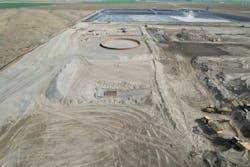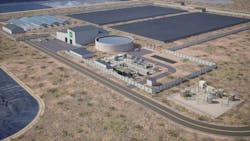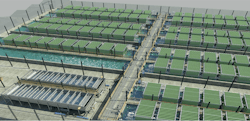Pasco Public Works Sees Benefits Ahead From Wastewater Treatment Project With Burnham RNG
With six growing food processing plants in Pasco, Washington, the Pasco Department of Public Works was keenly aware that the existing industrial wastewater reuse facility needed upgrading and expansion to handle the increased load. The city, nestled at the confluence of the Columbia, Yakima, and Snake rivers in the state's southeastern quadrant, captures agricultural wastewater from these food processors through a pipeline network and applies the water as irrigation to 1,800 acres of city-owned farmland. However, this wastewater contains nitrogen from the food processing, and Pasco has reached the nitrogen limit for land application in its permit. The increasing concentration of nitrogen has the potential to damage the underlying groundwater system, so until recently, the City of Pasco had to turn away new food processing operations, hindering the area's economic growth.
The city needed a new solution, one that Pasco Public Works hoped would make the best possible use of the organic waste products in the wastewater. So when the team at Sustainable Energy Ventures (SEV) came to Pasco looking for opportunities to build an anaerobic digester facility that produces renewable natural gas (RNG), Steve Worley, public works director of Pasco, took more than a passing interest in what they had to say.
“I explained our system, and they thought it was a good opportunity to look into whether renewable natural gas produced from an aerobic digestion would be a good byproduct to the treatment of our industrial wastewater,” said Worley.
SEV brought in their partner company, Burnham RNG, that provides solutions to communities like Pasco that process wastewater sustainably and transform the waste into energy and other valuable products.
“Pasco had a need to dispose of and treat wastewater, and a natural byproduct of that process is biogas — which can be upgraded to renewable natural gas,” said Chris Tynan, founder and CEO of Burnham RNG. “It’s a better way to reduce the carbon intensity of the system. If Pasco creates RNG, there are also tax benefits, and added revenue from gas sales will become big benefits in lowering treatment costs.”
Pasco Public Works put out a complex RFP, said Worley. “We were looking for companies that could be the designer, contractor, operator, maintainer, and financier,” he said. “Both Pasco and Burnham were very interested in finding innovative solutions, and we had to do it in a way that brought our processors along the way.”
HOW THE SYSTEM WORKS
The new Pasco Resource Recovery Center (PRRC), now under construction, will provide a sustainable industrial wastewater treatment system that benefits the food processing plants and the environment.
“We are incorporating the idea of industrial symbiosis in this — taking the waste from one industry and turning it into a valuable product in another industry,” said Worley. “We’re doing that three times over: RNG, fertilizer from the nitrogen removed, and then using the remaining water for irrigation and farming.”
The process begins by bringing wastewater into two anaerobic digesters supplied by Xylem, a proven wastewater treatment technology used for decades worldwide to handle a low organic load rate and high total suspended solids. The Xylem system maximizes the production of methane (biogas) while effectively reducing the biodegradeable organic matter left in the water.
The Pasco Resource Recovery Center under construction in September 2023. Once operational, the project will treat a max flow of over 9 million gallons per day and produce enough RNG to supply over 4,500 residential consumers in Washington State each year.
The biogas then undergoes an upgrading process that removes 95% of the foul-smelling hydrogen sulfide (H2S) and uses a three-stage membrane separation process to remove carbon dioxide and recover the methane. The result is high-quality renewable natural gas, which Cascade Natural Gas, a local gas utility, will purchase to serve its customers.
The remaining water moves into a revolving algal biofilm (RAB) system provided by Gross Wen Technologies (GWT), the most extensive RAB system to date. This process uses algae grown on a vertical belt, rotating through the treated wastewater to remove the nitrogen and phosphorous. The algae then consume the carbon dioxide in the surrounding atmosphere, replacing it with oxygen. The algae, now made nutrient-rich by its consumption of nitrogen and phosphorous, are harvested from the revolving belt and turned into pellets, creating a fertilizer product. This fertilizer can then be sold to cultivators of turf and gardens.
“The algae grown to remove the nitrogen could also become a source for future bio-aviation fuels,” said Worley. “Pacific Northwest National Laboratory has a biofuels program, taking algae and turning it into crude oil. The governor of Washington is very excited about Pasco being a source for this.”
Finally, whatever water remains after the nitrogen removal can be used in the city’s irrigation system for its agricultural land, where it grows alfalfa and corn, two nitrogen-uptake crops. The result: A zero-waste, or industrially symbiotic, wastewater treatment system that has already spurred economic growth.
Darigold, a PNW dairy co-op, is building a $600 million butter and protein powder processing plant in Pasco because of the new PRRC. Not only is the PRRC able to handle the additional wastewater and nutrients, but “They are an environmentally friendly and sustainable company,” said Worley, so “the new wastewater treatment plant made Pasco particularly attractive to them.”
“We can reuse more than two billion gallons of water a year in the new plant,” said Worley. “This also relieves our municipal wastewater plant from having to process some of this wastewater,” which creates more capacity for residential growth.
BALANCING BENEFITS AND COST
The City of Pasco’s food processors pay for the cost of building and operating the PRRC, so finding ways to make the project as affordable as possible is a top priority for both Pasco Public Works and Burnham RNG.
“Adding treatment when there was no treatment before is expensive,” said Tynan. “Producing the RNG helps hold the line on cost because there are federal tax credits for projects like this.”
Thanks to the Inflation Reduction Act, new wastewater treatment facilities that use anaerobic digestion to create and collect RNG qualify for investment tax credits, usually 30% of eligible capital costs, for projects in which construction starts before 2025.
Much of the food processing activity in Pasco is linked to seasonal agriculture, so most of the wastewater that goes into the plant is also seasonal, Tynan said. “So we have capacity to produce more gas in the off-season. We are actively working to find additional organic waste, like landfill diverted food scraps, that could be added to our digesters and turned into RNG.”
Carbon credits also offer diversified revenue, said Worley. “The amount of carbon taken out of the air in a year to grow the algae is equivalent to about 8,000 acres of forest land,” he said. “In Washington state, we have a process with carbon capture credits — the state is purchasing 800 acres of forest land so they can sell the carbon credits from these acres. So the amount of carbon we’re sequestering from our system is 10 times that project.”
This allows the potential for Pasco Public Works to offer carbon credits for purchase. “We have not delved into that yet,” said Worley, “but it sounds like a great opportunity to potentially monetize the technologies used by the new treatment system.”
The new Resource Recovery Center represents a commitment to a 30-year partnership between the City of Pasco and Burnham RNG, so there will be plenty of creative problem-solving to come. “I’ve been developing similar projects my whole career,” said Tynan, “but none have been as fun as this one.”



